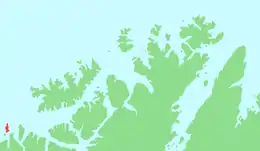Loppa (island)
Loppa (Old Norse: Loppa), (Northern Sami: Láhppi) is an island in Loppa Municipality in Troms og Finnmark county, Norway.[1] The 12-square-kilometre (4.6 sq mi) island lies in the Lopphavet Sea in the western part of the municipality, west of the island of Silda. The small island has one village area (called Loppa) on the southeastern coast. This village used to be the administrative centre of Loppa and an important fishing village for the municipality, but all of the administration of the village was moved to Øksfjord on the mainland. Today, Loppa Church is still located in this village, but there are only a few residents remaining on the island. In 1983, a seabird reserve was established along the western cliffs.[2]
| Native name: Láhppi | |
|---|---|
 | |
 Loppa Location of the island  Loppa Loppa (Norway) | |
| Geography | |
| Location | Troms og Finnmark, Norway |
| Coordinates | 70.3586°N 21.4139°E |
| Area | 12 km2 (4.6 sq mi) |
| Length | 7.5 km (4.66 mi) |
| Width | 2.5 km (1.55 mi) |
| Highest elevation | 289 m (948 ft) |
| Highest point | Rektind |
| Administration | |
Norway | |
| County | Troms og Finnmark |
| Municipality | Loppa Municipality |
Archaeological findings
Roman Age
Little is known of this period historically and archaeologically on Loppa. However the discovering of a Roman Age longhouse from 120 AD,[3] at the island of Loppa shows the earliest signs of settlement in the Early Iron Age. Perhaps was this the very beginning of Norse and Sami collaboration in the area and the interaction between the two peoples of trade and commerce in fishing and the industry of the hunting of maritime mammals.[4][5] The longhouse is also one of the oldest one ever discovered in Northern Norway.
Viking Age
In 1962 a rich female Viking Age grave was discovered on the island of Loppa. It contained luxurious personal objects such as tortoise brooches, a round brooch in the Oseberg style, a whalebone plaque, beads, knife, scissor and an arrowhead. The female grave was dubbed "The Queens Grave" due to the manner in which she was buried, however she was most likely not a queen but a very important person indeed on Viking Age Loppa, perhaps a housewife of a local chieftain. The wealth of the grave reflects that of the Norse elite's presence in the area. The burial was dated to the 9th century AD.[3][6][7]
In 1964 a longhouse from Viking Age was also discovered dated to the end of the 8th century AD. Several other buildings and boathouses was also discovered and dated to the same period as the longhouse and the rich female grave. There is also several burials from Iron Age on the island, the biggest a burial cairn with the size of 13 meters in diameter. The amount of Iron Age burials and houses suggests that of a more permanent Norse settlement.[7]
Middle Ages
In Middle Ages, the hunting and the production of oil from marine mammals seems to stop, and fishing becomes more important. Along the coast of Northern Norway we see so called farm mounds of ancient settlements, and at Loppa there are at least 6 farm mounds spread out on the island of Loppa, Silda and at mainland Andsnes. However, the farm mounds of Northern Norway seem to have their upbringing already in Early Iron Age, suggesting that fishing was already a commercial trade before the Middle Ages. On the island of Loppa one of the farm mounds was dated to the 1100s AD, with a church site close by. This suggests that Loppa was already a parish in the Middle Ages.[7][8]
See also
References
- "Loppa" (in Norwegian). yr.no. Retrieved 2013-01-01.
- Askheim, Svein, ed. (2017-10-02). "Loppa øy". Store norske leksikon (in Norwegian). Kunnskapsforlaget. Retrieved 2018-06-23.
- Bratrein, Håvard Dahl (1996). Ottar Tidsskrift. Tromsø Museum.
- Ellingsen, Gøran Hálfdanarson (2017). Loppa - An Iron Age settlement in the periphery of Hálogaland (Thesis) (in Norwegian).
- Henriksen, Jørn Erik (1995). "Hellegropene, fornminner fra en funntom periode". Academia.edu.
- Storli, Inger (2006). Hålogaland før rikssamlingen. Institutt for sammenliknende forskning.
- Bratrein, Håvard Dahl. Feltrapport fra 1994.
- Bruun, Inga Malene (2009). Kulturminneregistrering i gamle fiskevær. Tromsø Museum.